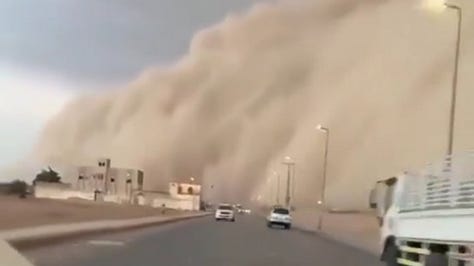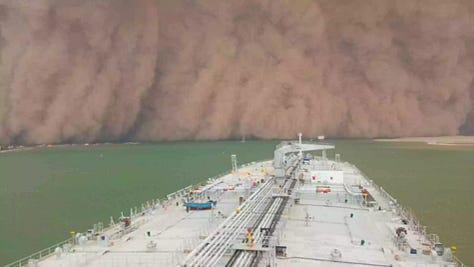Storms, Fires, and Chaos: Israel Faces Nature’s Wrath Amid Its Gaza Offensive
As Israel battles unprecedented wildfires and sandstorms, the nation faces growing scrutiny for seeking international aid while maintaining a devastating blockade on Gaza.
Occupied Palestine, PUREWILAYAH.COM - Southern Israel is currently facing a convergence of extreme weather events rarely seen before: massive sandstorms, scorching heatwaves, and widespread wildfires are unfolding simultaneously, particularly in areas such as the Negev Desert and Beersheba. These natural disasters strike during a period of national tension and bitter irony, as Israel continues its brutal military campaign against Palestinians in Gaza.
Orange Skies and Thick Smoke Blanket Southern Israel
According to reports by NDTV and NewsX World, the sandstorm has drastically reduced visibility and intensified wildfires already raging on the outskirts of Jerusalem. Footage shows skies turning a deep orange as flames engulf sections of Route 1, the major highway connecting Jerusalem and Tel Aviv. Dozens of vehicles were abandoned while residents fled the advancing fire.
The storm also reached an Israeli military base in the Negev, where circulating videos showed soldiers struggling to shut gates due to strong winds. The conditions disrupted not only civilian life but also affected military installations central to Israel’s ongoing operations in Gaza.
Heatwave Warning as Temperatures Near 40°C
Meteorologist Lior Sudri, quoted by Israel National News, described the weather as “extreme,” marked by strong winds, dense haze, and heat peaking at nearly 38°C. “The sandstorm is expected to strike southern regions, while the coastal areas will experience the highest temperatures,” he stated.
National Ceremony Cancelled
In response to the severe weather, the Israeli government made the rare decision to cancel the live ceremony marking the country’s 77th Independence Day. Instead, a pre-recorded version of the opening ceremony was broadcast on national television Wednesday evening.
The timing of the sandstorm added further disruption, coinciding with Israel’s transition from Memorial Day to what it is called as Independence Day.
A Day of “Independence” or a Day of Displacement?
It is crucial to recognize that what Israel celebrates as “Independence Day” is, for Palestinians, known as Nakba Day—“The Day of Catastrophe.”
Nakba refers to the events of 1948, when the so-called establishment of the State of Israel was marked by the forced expulsion of approximately 700,000 Palestinians, along with the destruction of more than 500 towns and villages. Many of these were erased from maps, their original names and histories lost under new designations.
Nakba Day is commemorated annually on May 15. The Israeli observance of independence, by contrast, is based on the Hebrew calendar and typically falls a few days earlier in the Gregorian calendar.
Even in the most basic understanding of justice, there can be no justification for celebrating a state founded on ethnic cleansing and dispossession. True independence cannot exist when it is built upon the usurpation of another people’s freedom, land, and rights.



Seeking International Help While Maintaining the Siege on Gaza
As massive wildfires have ravaged areas surrounding Jerusalem since April 30, 2025, Israel has appealed for international assistance to contain the disaster. Over 25,000 dunams (approximately 6,170 hectares) have burned, forcing the evacuation of more than 10,000 residents and injuring at least 45 people.
In response, Italy, Croatia, Greece, Cyprus, and Bulgaria have sent firefighting aircraft to assist Israel.
However, in stark contrast, Israel continues to enforce a total blockade on Gaza—in effect since March 2, 2025. The blockade has triggered a catastrophic humanitarian crisis.
Over 3,000 trucks carrying humanitarian aid remain stuck at Gaza’s borders, while UN agencies warn that more than 1 million children in Gaza face acute hunger and severe malnutrition.
When Nature Strikes Back
While wildfires rage and sandstorms choke the skies over southern Israel, many observers cannot ignore the unsettling symbolism of nature’s upheaval coinciding with the country’s continued military assault on Gaza.
As the land burns and visibility vanishes in thick, apocalyptic haze, the contrast is stark: a nation seeking global assistance for its own natural disaster, while imposing an unrelenting blockade that fuels a human-made catastrophe just across its borders.
In a moment where the environment itself seems to rebel, the dual crises raise uncomfortable questions about justice, responsibility, and the moral cost of occupation. (PW)

